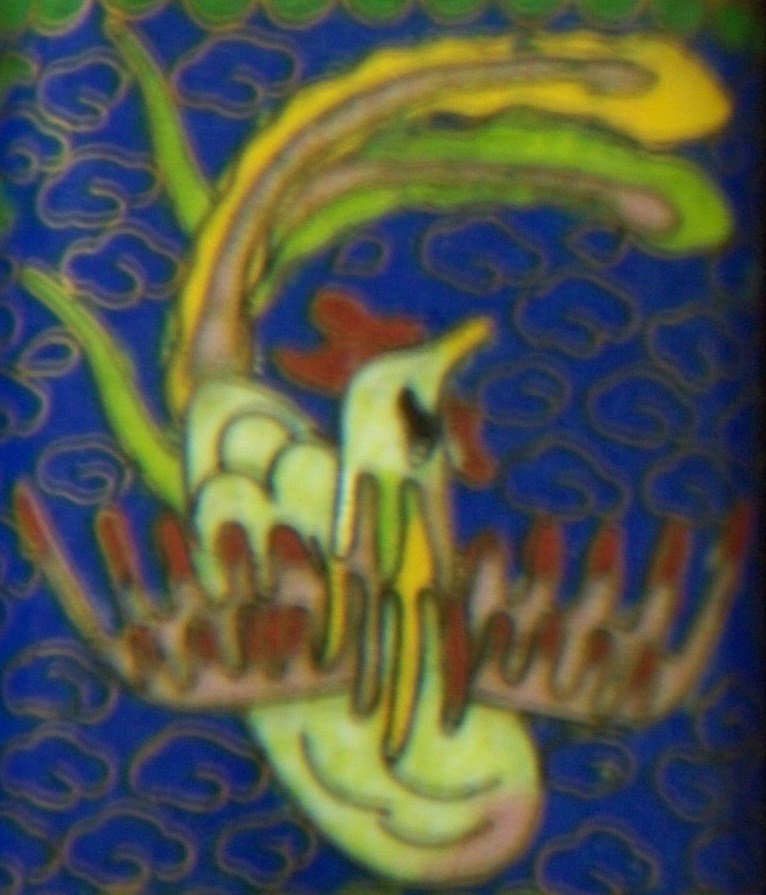In my quest to discover what the tell-tale signs were to
distinguish older Chinese cloisonné beads from newer products, one of the
motifs I noticed that changed with the decades was the little wire cloud used
to stabilize the background enamel (the JingFa Cloud). Another is the construction method for blossom buds.
This little bowl is clearly prior to World War II because of
its red “CHINA” marking on the bottom.
According to Internet lore (I haven't fact-checked this) the 1890 McKinley Tariff Act was further amended in 1921 to require “Made In” to
be added to the country-origin mark for items for export to the United States. Many shops continued to mark their wares as
they always had, exporters simply pasting “Made in China” paper labels onto
items destined for the U.S.
Note the three different types of marks on these items that
were clearly produced by the same workshop.
To continue with the examination of our little bowl, note
the way the blossom buds are wired: a central round wire, with arcs from the
same circle on either side. Three pieces
of wire.
 |
| 3-wire buds |
In other cloisonné items that seem to date from the
1920s-1940s, a blossom bud appears that is made of a single wire curved into 3
loops:
 |
| 3-loop buds |
In this exceptionally nice pair of vases [pictures
courtesy of eBay vendor splicer9], their “Made In China” base stamp dating them
to between 1921 and 1949, both styles of blossom buds are apparent. Whether this was one artist working two
variations on a theme, or co-workers with two different ideas as to how to execute
the blossom branch motif, we’ll likely never know.
Contrast the older vase pair with a nice mirror-image JingFa
pair likely of post-70s manufacture:
A nice set of beads featuring buds made by the 3-loop method, various clouds and spirals, and a Morning Glory Clasp.
This charm bracelet, based upon the style of clasp, seems
likely to date from the 1930s. The style
of the cloisonné bead is also consistent with other cloisonné beads used in
costume jewelry at that time – a rather large bead, with a limited palette of opaque
enamel colors.
The bud motifs are
comparatively large, as if the same diameter circular jig used for
household items had simply been appropriated to make the bead wires. Three pieces of wire to make a bud.
Here’s another piece that has a late 30s-early 40s look to
it. Again, note the limited enamel palette,
but this time the blossom buds are comparatively small and calibrated to the
overall design.
 |
| Each pendant measures 35x28mm |
Necklaces with nicer silver or cloisonné clasps that display the 3-wire bud, with spirals and peaked clouds:
 |
| Beads are 15mm |
This rare little set of beads, that came accompanied with
credible provenance from the 1950s, shows the 3-wire blossom bud accompanied by tiny JingFa clouds:
 |
| Beads are 12mm |
Here is the seller’s touching account:
My parents are
Russian, and my father’s first job after graduation (he is a geologist) was in
China, it was 1955-1958, I believe (I was not born yet). They traveled all over China, spending a few
months here and there (my mom and my brother in some town and father “in the
field” – surveying the surrounding areas).
Definitely Peking and Shanghai, but also Chuntsin in the South and more
places whose names I don’t remember. My
mom lives with me here now, but she is 82 and her memory is not good. I found those beads among her things when I
moved her, but she can’t remember where they are from; she thinks she got them
in China.”
The original silk knotting had deteriorated and the clasp
had disappeared, so the seller re-strung the beads with wire loops. Those curious about the history of the time
can read Wikipedia on the Sino-Soviet Split, as well as Tombstone and Mao’sGreat Famine. Once again, tiny trinkets
like beads get caught up in the whirlpools of history.
As described in a prior post, the JingFa cloisonné factory
cooperative was formed in 1956. What
appears on pieces clearly of JingFa manufacture (as evidenced by the stereotypical
little cloud motifs also on these pieces) is a new method for making a blossom
bud out of one continuous wire: the center is curved into a sort of pinched
droplet, then two “wings” are formed on the same curve and bent somewhat to
butt their ends against the center drop.
The buds often look a bit elongated, as the central droplet often isn’t
perfectly circular. The wire ends are at
the tip of the bud, not against the base near the stem.
 |
| JingFa buds |
As with the older “crinkle” and “peaked spiral” clouds, the
3-wire and 3-loop blossom buds could have been continued to be used by other workshops, or by different artisans working under the JingFa cooperative. It’s not as if a gong was sounded and use of
older motifs ceased – more examples can be found with both the JingFa Cloud and the
older style 3-wire bud:
One possible
explanation for this is that the JingFa style of cloud appears on cloisonne items made before 1956 –
but the evidence for that so far is entirely lacking. The more likely explanation seems to be older
craftspersons or senior artists continuing to make cloisonné motifs in their
usual manner, using tiny JingFa clouds right along with peaked clouds and
spirals. This Montreal Gazette article from 1973 describes how older craftspeople were recruited to restore
traditional designs after products of the Cultural Revolution proved unappealing.
However, like the older cloud styles, eventually
the 3-wire and 3-loop buds disappear, and only the JingFa bud appears. |
| Neatly made JingFa clouds and blossom buds, on a giant bead probably made sometime circa 1970. |














.jpg)





































